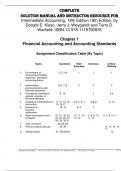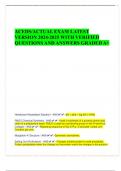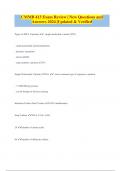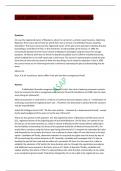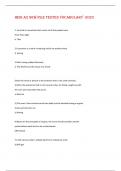Complete
Solution Manual and Instructor Resource for
Intermediate Accounting, 18th Edition 18th Edition, by
Donald E. Kieso, Jerry J. Weygandt and Terry D.
Warfield. ISBN-13 978-1119790976
Chapter 1
Financial Accounting and Accounting Standards
Assignment Classification Table (By Topic)
Topics Questions Brief Exercises Critical
Exercises Thinking
1. Environment of 1,2, 3,4 1 1 1
accounting, principles,
objectives, standards,
accounting theory.
2. Authoritative 5,6, 7,8 2 2 2
pronouncements and
rule-making bodies.
3. Conceptual framework- 9, 10 3 3,4
general, objective of
financial reporting.
4. Qualitative characteristics of 11,12, 13, 14, 3,4, 5, 6, 7 4,5,6 5, 10
accounting. 15, 16,17
5. Elements of 18, 19 8, 9 7
financial
statements.
6. Basic assumptions and 20, 21, 22, 23, 10, 11, 12, 4, 8, 9, 10, 6, 7, 8, 9, 11
principles. 24, 25, 26, 27, 13, 14 11, 12
28, 29, 30,31
7. Cost constraint. 32,33,34
8. Role of pressure groups. 35, 36 12, 14, 15, 16,
17
9. Ethical issues. 37, 38,39,40 13
Copyright © 2022 WILEY Kieso, Intermediate Accounting, 18/e, Solutions Manual (For Instructor Use Only) 5-1-1
, Assignment Classification Table (By Learning Objective)
Learning Objectives Questions Brief Exercises Critical
Exercises Thinking
1. Describe the financial reporting 1, 2, 3, 4, 1, 2 1, 2 1
environment, major standard- 5, 6, 7, 8
setting bodies, and the meaning
of generally accepted accounting
principles (GAAP).
2. Describe the components and 9, 10, 11, 12, 3, 5, 6, 3, 4, 5, 6, 7 2,3,4, 5,
usefulness of the conceptual 13, 14, 15, 16, 7, 8,9 10
framework. 17, 18, 19
3. Discuss the basic assumptions 20, 21, 22, 23, 4, 10, 11, 8, 9, 10, 11, 6, 7, 8, 9,
and principles of accounting. 24, 25, 26, 27, 12, 13, 14 12 11, 12
28, 29, 31,
32, 33, 34
4. Identify the major challenges in 30, 35, 36, 37, 2 11, 13, 14,
the financial reporting 38, 39,40 15, 16
environment.
Assignment Characteristics Table (Time on Task)
Item Description Level of Time
Difficulty (minutes)
E1.1 Need for GAAP. Simple 15-20
E1.2 Financial reporting and accounting standards. Simple 15-20
E1.3 Usefulness, objective of financial reporting. Simple 15-20
E1.4 Usefulness, objective of financial reporting, Simple 15-20
qualitative characteristics.
E1.5 Qualitative characteristics. Moderate 20-30
E1.6 Qualitative characteristics. Simple 15-20
E1.7 Elements of financial statements. Simple 15-20
E1.8 Assumptions, principles, and constraint. Simple 15-20
E1.9 Assumptions, principles, and constraint. Moderate 20-25
E1.10 Full disclosure principle. Complex 20-25
E1.11 Accounting principles and assumptions- Moderate 20-25
E1.12 comprehensive.
Accounting principles-comprehensive. Moderate 20-25
CT1.1 Securities and Exchange Commission. Moderate 30-40
CT1.2 Conceptual framework-general. Simple 20-25
CT1.3 Conceptual framework-general. Simple 25-35
CT1.4 Objective of financial reporting. Moderate 25-35
CT1.5 Qualitative characteristics. Moderate 30-35
5-1-2 Copyright © 2022 WILEY Kieso, Intermediate Accounting, 18/e, Solutions Manual (For Instructor Use Only)
, CT1.6 Revenue recognition principle. Complex 25-30
CT1.7 Expense recognition principle. Complex 20-25
CT1.8 Expense recognition principle. Moderate 20-25
CT1.9 Expense recognition principle. Moderate 20-30
CT1.10 Qualitative characteristics. Moderate 20-30
CT1.11 Expense recognition principle. Moderate 20-25
CT1.12 Cost Constraint. Moderate 30-35
CT1.13 Rule-making Issues. Complex 20-25
CT1.14 Models for setting GAAP. Simple 15-20
CT1.15 Economic consequences. Moderate 25-35
CT1.16 GAAP and economic consequences. Moderate 25-35
Answers to Questions
1. If a company‘s financial performance is measured accurately, fairly, and on a timely basis, the right
managers and companies can attract investment capital. Unreliable and irrelevant information leads
to poor capital allocation, which adversely affects the efficiency of the securities market.
LO: 1, Bloom: K, Difficulty: Simple, Time: 1-3, AACSB: Communication, AICPA BC: None, AICPA AC: Reporting, AICPA PC: Communication
2. The objective of general purpose financial reporting is to provide financial information about the
reporting entity that is useful to present and potential equity investors, lenders, and other creditors
in making decisions about providing resources to the entity through equity investments and loans or
other forms of credit. Information that is decision-useful to capital providers (investors) may also be
useful to other users of financial reporting who are not investors.
LO: 1, Bloom: K, Difficulty: Simple, Time: 3-5, AACSB: Communication, AICPA BC: None, AICPA AC: Reporting, AICPA PC: Decision Making
3. Investors are interested in financial reporting because it provides information that is useful for
making decisions (referred to as the decision-usefulness approach). When making these
decisions, investors are interested in assessing the company‘s (1) ability to generate net cash
inflows and (2) management‘s ability to protect and enhance the capital providers‘ investments.
Financial reporting should therefore help investors assess the amounts, timing, and uncertainty of
prospective cash inflows from dividends or interest, and the proceeds from the sale, redemption,
or maturity of securities or loans. For investors to make these assessments, the economic
resources of an enterprise, the claims to those resources, and the changes in them must be
understood.
LO: 1, Bloom: K, Difficulty: Simple, Time: 3-5, AACSB: Communication, AICPA BC: None, AICPA AC: Reporting, AICPA PC: Decision Making
4. A common set of financial accounting and reporting standards applied by all businesses and
entities should produce financial statements which are reasonably comparable. Without a common
set of standards, each enterprise could, and would, develop a theory structure and set of
practices, resulting in noncomparability among the financial statements of enterprises.
LO: 1, Bloom: K, Difficulty: Simple, Time: 3-5, AACSB: Communication, AICPA BC: None, AICPA AC: Reporting, AICPA PC: Communication
5. The SEC has the power to prescribe, in whatever detail it desires, the accounting practices and
principles to be employed by companies that fall within its jurisdiction. Because the SEC receives
audited financial statements from nearly all companies that issue securities to the public or are listed
on stock exchanges, it is greatly interested in the content, accuracy, and credibility of the statements.
For many years, the SEC relied on the AICPA to regulate the profession and develop and enforce
accounting principles. Lately, the SEC has assumed a more active role in the development of
Copyright © 2022 WILEY Kieso, Intermediate Accounting, 18/e, Solutions Manual (For Instructor Use Only) 5-1-3
, accounting standards, especially in the area of disclosure requirements. In December 1973, in ASR
No. 150, the SEC said the FASB‘s statements would be presumed to carry substantial authoritative
support and anything contrary to them to lack such support. It thereby supports the development of
accounting principles in the private sector.
LO: 1, Bloom: K, Difficulty: Simple, Time: 3-5, AACSB: Communication, AICPA BC: None, AICPA AC: Reporting, AICPA PC: Communication
6. The explanation should note that generally accepted accounting principles or standards have
―substantial authoritative support.‖ They consist of accounting practices, procedures, concepts,
and methods that are recognized by a large majority of practicing accountants as well as other
members of the business and financial community. Statements issued by the Financial Accounting
Standards Board constitute ―substantial authoritative support.‖
LO: 1, Bloom: K, Difficulty: Simple, 5-10, AACSB: Communication, AICPA BC: None, AICPA AC: Reporting, AICPA PC: Communication
Questions Chapter 1 (Continued)
7. The FASB Accounting Standards Codification (Codification) is a compilation of all GAAP in one
place. Its purpose is to integrate and synthesize existing GAAP, not to create new GAAP. It creates
one level of GAAP which is considered authoritative. The FASB Codification Research Systems
(CRS) is an online real-time database that provides easy access to the Codification. The Codification
and the related CRS provide a topically organized structure that is subdivided into topics, subtopics,
sections, and paragraphs.
LO: 1, Bloom: K, Difficulty: Moderate, Time: 5-7, AACSB: Communication, AICPA BC: None, AICPA AC: Reporting, AICPA PC: Communication
8. It is hoped that the Codification will help users to better understand what GAAP is. If this occurs,
companies will be more likely to comply with GAAP and the time to research accounting issues will
be substantially reduced. In addition, through the electronic web-based format, GAAP can be easily
updated which will help users stay current.
LO: 1, Bloom: K, Difficulty: Simple, Time: 3-5, AACSB: Communication, AICPA BC: None, AICPA AC: Reporting, AICPA PC: Communication
9. A conceptual framework is a coherent system of interrelated objectives and fundamentals that can
lead to consistent standards and that prescribes the nature, function, and limits of financial account-
ing and financial statements. A conceptual framework is necessary for financial accounting for the
following reasons:
(1) It enables the FASB to issue more useful and consistent standards in the future.
(2) New issues will be more quickly solvable by reference to an existing framework of basic theory.
(3) It increases financial statement users‘ understanding of and confidence in financial reporting.
(4) It enhances comparability among companies‘ financial statements.
LO: 2, Bloom: K, Difficulty: Simple, Time: 3-5, AACSB: Communication, AICPA BC: None, AICPA AC: Reporting, AICPA PC: Communication
10. The objective of financial reporting is to provide financial information about the reporting entity that
is useful to present and potential equity investors, lenders, and other creditors in making decisions
about providing resources to the entity.
LO: 2, Bloom: K, Difficulty: Simple, Time: 3-5, AACSB: Communication, AICPA BC: None, AICPA AC: Reporting, AICPA PC: Communication
11. ―Qualitative characteristics of accounting information‖ are those characteristics that contribute to
the quality or value of the information. The overriding qualitative characteristic of accounting infor-
mation is usefulness for decision-making.
LO: 2, Bloom: K, Difficulty: Simple, Time: 3-5, AACSB: Communication, AICPA BC: None, AICPA AC: Reporting, AICPA PC: Communication
12. Relevance and faithful representation are the two fundamental qualities of useful accounting
information. For information to be relevant, it should be capable of making a difference in a decision
by helping users to form predictions about the outcomes of past, present, and future events or to
5-1-4 Copyright © 2022 WILEY Kieso, Intermediate Accounting, 18/e, Solutions Manual (For Instructor Use Only)

